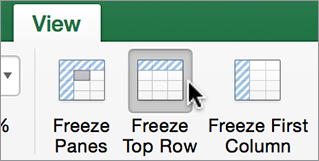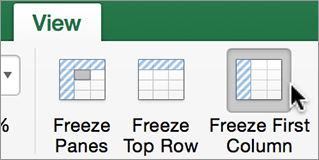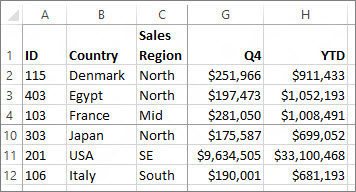Freeze panes to lock the first row or column
You want to scroll, but you want to see your top row or left column to stay still. To do this, you use the Freeze buttons on the View tab. If the Freeze buttons aren't available on the View tab, make sure you switch to Normal view. On the View tab, click Normal.
Freeze the top row
On the View tab, click Freeze Top Row.

When you do this, the border under row 1 is a little darker than other borders, meaning that the row above it is frozen.
Freeze the first column
If you'd rather freeze the leftmost column instead, on the View tab, click Freeze First Column.

When you do this, the line to the right of column A is a little darker than the other lines, meaning that the column to its left is frozen.
Freeze the top row and the first column
To freeze the top row and the first column at the same time, click cell B2. Then, on the View tab, click Freeze Panes.
Freeze as many rows or columns as you want
Want to freeze multiple rows and/or columns? You can freeze as many as you want, as long as you always start with the top row and the first column. To freeze multiple rows (starting with row 1), select the row below the last row you want frozen and click Freeze Panes. To freeze multiple columns, select the column to the right of the last column you want frozen and click Freeze Panes.
Say you want to freeze the top four rows and leftmost three columns. You'd select cell D5, and then on the View tab, click Freeze Panes. Any time you freeze rows and columns, the border below the last frozen row and to the right of the last frozen column appears a little thicker (here, below row 4 and to the right of column C).

Unfreeze rows or columns
Want to unfreeze a row, column, or both? On the View tab, click Unfreeze Panes.
No comments:
Post a Comment